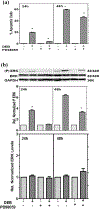Diepoxybutane-induced apoptosis is mediated through the ERK1/2 pathway
- PMID: 29405768
- PMCID: PMC12089703
- DOI: 10.1177/0960327118755255
Diepoxybutane-induced apoptosis is mediated through the ERK1/2 pathway
Abstract
Diepoxybutane (DEB) is the most potent active metabolite of butadiene, a regulated air pollutant. We previously reported the occurrence of DEB-induced, p53-dependent, mitochondrial-mediated apoptosis in human lymphoblasts. The present study investigated the role of the extracellular signal-regulated protein kinases 1 and 2 (ERK1/2) pathway in DEB-induced apoptotic signaling in exposed human lymphoblasts. Activated ERK1/2 and mitogen-activated protein (MAP) kinase/ERK1/2 kinase (MEK) levels were significantly upregulated in DEB-exposed human lymphoblasts. The MEK inhibitor PD98059 and ERK1/2 siRNA significantly inhibited apoptosis, ERK1/2 activation, as well as p53 and phospho-p53 (serine-15) levels in human lymphoblasts undergoing DEB-induced apoptosis. Collectively, these results demonstrate that DEB induces apoptotic signaling through the MEK-ERK1/2-p53 pathway in human lymphoblasts. This is the first report implicating the activation of the ERK1/2 pathway and its subsequent role in mediating DEB-induced apoptotic signaling in human lymphoblasts. These findings contribute towards the understanding of DEB toxicity, as well as the signaling pathways mediating DEB-induced apoptosis in human lymphoblasts.
Keywords: Diepoxybutane; ERK1/2; apoptosis; butadiene; extracellular signal–regulated protein kinase; p53.
Conflict of interest statement
Declaration of Conflicting Interests
The author(s) declare that there is no potential conflict of interest with respect to the research, authorship, or publication of this article.
Figures




Similar articles
-
Diepoxybutane induces the p53-dependent transactivation of the CCL4 gene that mediates apoptosis in exposed human lymphoblasts.J Biochem Mol Toxicol. 2023 May;37(5):e23316. doi: 10.1002/jbt.23316. Epub 2023 Feb 12. J Biochem Mol Toxicol. 2023. PMID: 36775894 Free PMC article.
-
Diepoxybutane induces caspase and p53-mediated apoptosis in human lymphoblasts.Toxicol Appl Pharmacol. 2004 Mar 1;195(2):154-65. doi: 10.1016/j.taap.2003.11.006. Toxicol Appl Pharmacol. 2004. PMID: 14998682
-
Diepoxybutane induces the expression of a novel p53-target gene XCL1 that mediates apoptosis in exposed human lymphoblasts.J Biochem Mol Toxicol. 2020 Mar;34(3):e22446. doi: 10.1002/jbt.22446. Epub 2020 Jan 18. J Biochem Mol Toxicol. 2020. PMID: 31953984 Free PMC article.
-
Mechanism of diepoxybutane-induced p53 regulation in human cells.J Biochem Mol Toxicol. 2009 Nov-Dec;23(6):373-86. doi: 10.1002/jbt.20300. J Biochem Mol Toxicol. 2009. PMID: 20024960 Free PMC article.
-
A review of the genetic and related effects of 1,3-butadiene in rodents and humans.Mutat Res. 2000 Oct;463(3):181-213. doi: 10.1016/s1383-5742(00)00056-9. Mutat Res. 2000. PMID: 11018742 Review.
Cited by
-
Induced Cell Death as a Possible Pathway of Antimutagenic Action.Bull Exp Biol Med. 2021 May;171(1):1-14. doi: 10.1007/s10517-021-05161-z. Epub 2021 May 29. Bull Exp Biol Med. 2021. PMID: 34050413
-
Diepoxybutane induces the p53-dependent transactivation of the CCL4 gene that mediates apoptosis in exposed human lymphoblasts.J Biochem Mol Toxicol. 2023 May;37(5):e23316. doi: 10.1002/jbt.23316. Epub 2023 Feb 12. J Biochem Mol Toxicol. 2023. PMID: 36775894 Free PMC article.
References
-
- Albertini RJ, Carson ML, Kirman CR, et al. 1,3-Butadiene: II. Genotoxicity profile. Crit Rev Toxicol 2010; 40 Suppl 1: 12–73. - PubMed
-
- Albertini RJ, Carter EW, Nicklas JA, et al. 1,3-Butadiene, CML and the t(9:22) translocation: a reality check. Chem Biol Interact 2015; 241: 32–39. - PubMed
-
- National Toxicology Program. 1,3-Butadiene. National Toxicology Program, Report on Carcinogens. Research Triangle Park, NC: U.S. Department of Health and Human Services, Public Health Service. 14th ed. 016. Available at: https://ntp.niehs.nih.gov/go/roc14/.
MeSH terms
Substances
Grants and funding
LinkOut - more resources
Full Text Sources
Other Literature Sources
Research Materials
Miscellaneous

